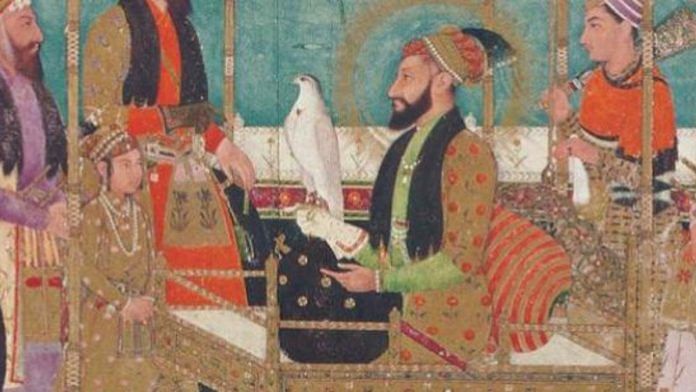In September 1657, as the Ganga dynasty ruled Palmares, the world’s greatest potentate Shahjahan did not appear at the balcony for the jharokha at the Red Fort: he was ill.
After Mumtaz’s death, Shahjahan had consoled himself in a priapic spree, powered by aphrodisiacs, ranging through his harem but also seducing wives of his courtiers, often picked up at palace bazaars that he patrolled, accompanied by two Tatar concubines who noted his choices. Later his beautiful Mumtazesque daughter Jahanara arranged his assig- nations, an intimacy that led to gossip that she also became his lover. Of his four sons, he favoured the first, Darashukoh, who was diffident, naive and innovative, challenging religious orthodoxy as Akbar had done. But this offended strict Muslims – such as the third son. Aurangzeb, fierce, morose, abstemious, who now served as his father’s roving paladin. Starting in 1636, aged only seventeen, he tried to expand from their Afghan base of Kabul and, failing there, he turned to Deccan.
Aurangzeb was married to an Iranian princess, Dilras Banu Begum, with whom he had five children. Then in 1653, the prim ascetic noticed Hira Bai Zainabadi, a singer-dancer in his aunt’s household, climbing a tree to pick a juicy mango, ‘a heart-robbing movement’.
Aurangzeb ‘obtained her possession from his indulgent aunt and . . . he gave her his heart’. He poured her wine but refused to drink himself, until one day she ‘put a glass in his hand and urged him to drink. Though he begged and prayed, she had no pity, and the prince was about to drink when the sly girl drank it.’
Also read: ‘No problem before’ — Aurangzeb tomb caretaker says tension stoked by Owaisi visit ‘rare blip’
‘It was to test your love,’ she laughingly told the mortified Aurangzeb. When just a year later Hira Bai died, Aurangzeb was heartbroken, but, he reflected, ‘God had been gracious to him by putting an end to that dancing girl’s life.’ He emerged from the affair ice-cold.
Now that Shahjahan was ill, Darashukoh claimed the regency, sparking a ferocious family war. Aurangzeb watched and waited while the other two brothers, Shahshuja and Murad, declared themselves padishah. Shahjahan wanted to leave his sickbed to persuade his sons to return to their provinces, but the overconfident Darashukoh refused.
Their sister Jahanara tried to mediate, until Aurangzeb discovered his father was colluding with Darashukoh. In June 1658, Aurangzeb be- sieged Shahjahan in the Agra fort, cutting off the water and reducing the old emperor to pathetic poetry:
My son my hero . . . yesterday I had an army of 900,000, Today I’m in need of a pitcher of water.
‘As we reap, we sow,’ wrote Aurangzeb on his father’s letter. ‘You did not love me,’ he later told his father. Shahjahan surrendered. Aurangzeb invited Murad to a boozy feast. Sleeping it off, Murad was arrested then later murdered. While Darashukoh fled, Shahshuja was defeated and escaped to Burma, where he perished.
Also read: Aurangabad or Sambhajinagar? Far from Kashi, communal politics simmers in Aurangzeb’s capital
‘Darashukoh must be exterminated,’ said Aurangzeb. In August 1659, Darashukoh was betrayed and then beheaded, his son Sulaymanshukoh forced to drink opium until he overdosed. Aurangzeb had Darashukoh’s headless body paraded on an elephant. When the head was delivered to him, Aurangzeb refused to look – ‘As I didn’t wish to see this infidel’s head in his lifetime, I don’t now’ – but it is possible he sent it to their father, who resided at the Agra fort with Jahanara. Aurangzeb insisted that he only assumed ‘the perilous burden of crown out of necessity and not free will’. He lectured his father: ‘When you fell ill, Darashukoh usurped power to promote Hinduism and destroy Islam,’ while he himself had won because ‘I’ve always been a faithful defender of the Quran.’ His brothers had to die, ‘due to the demands of justice’.
Emperor at forty, Aurangzeb became Alamgir – World Seizer. Under him, House Tamerlane reached its Indian zenith. Alamgir at first enjoyed music and patronized musicians. He fell for an enslaved teenaged Georgian concubine-dancer, Udaipuri, whom he had inherited from his murdered brother Darashukoh. His favourite daughter, the poetess Zebunnissa, on his succession, was permitted considerable freedom, but she became too independent. ‘Oh Makhfi, it is the path of love and alone you must go,’ she wrote. She was also having a public affair with a young nobleman and communicating with her mutinous brothers. Alamgir imprisoned her for twenty years.
This micromanaging puritan tried to limit sensuality, banning women from wearing tight trousers and, in Kashmir, ordering people to wear drawers instead of nothing. As his court became more rigorous and orderly, he lectured his son Azzam, ‘Fear the sighs of the oppressed,’ and warned his vizier, ‘Oppression will cause darkness on Judgement Day.’ Alamgir was probably the hardest-working ruler in Indian history, barely sleeping, poring over his paperwork: ‘I was sent into the world by providence to live and labour, not for myself but for others.’ Often reflecting on power, he was a Machiavellian – ‘One can’t rule without deception’ – and violent. ‘The greatest conquerors,’ he claimed, ‘aren’t the greatest kings,’ but this scion of Tamerlane lived for conquest: ‘When you have an enemy to destroy, spare nothing, anything is permissible . . . that can deliver success.’
For all his talk of justice, Alamgir restored dominion over Punjab by executing the Sikh guru Tegh Bahadur, crushed Afghan resistance, then devoted his reign to conquest of the south, where his ambitions collided with those of a charismatic Hindu warrior.
In 1660, Alamgir sent an army to destroy a descendant of one of Ambar’s generals, a Hindu warlord named Shivaji, who based at Pune rebelled against the sultan of Bijapur and started to craft a kingdom in the Deccan. In 1659, at a meeting with a Bijapuri general, Shivaji used a tiger claw in his sleeve to eviscerate his opponent, then smashed his army. He stressed that the Mughals were Turkish foreigners. Instead he aspired to create a Hindavi swarajya – a Hindu Indian kingdom.
 This excerpt from Simon Sebag Montefiore’s ‘The World: A Family History’ has been published with permission from Hachette India / Orion Publishing Group.
This excerpt from Simon Sebag Montefiore’s ‘The World: A Family History’ has been published with permission from Hachette India / Orion Publishing Group.



